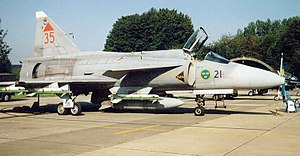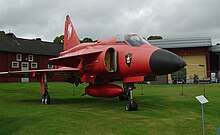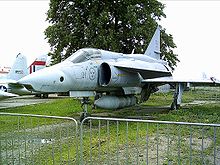Saab 37
| Saab JA 37 Viggen | |
|---|---|
 Saab JA 37 "Viggen" of the Swedish Air Force |
|
| Type: | Multipurpose fighter |
| Design country: | |
| Manufacturer: | |
| First flight: |
February 8, 1967 |
| Commissioning: |
June 21, 1971 |
| Production time: |
1970 to 1990 |
| Number of pieces: |
329 |
The Saab JA 37 Viggen ( German thunderbolt or tufted duck ) is a Swedish jet-powered, single-seat fighter aircraft. The term JA stands for Jakt och Attack (Swedish for hunting and attack ).
History of origin
Sweden's defense system provides for the use of high-performance fighter aircraft on runways of any length in wartime, which requires these machines to have STOL properties (short take-off and landing distances combined with high rates of descent). The multi-purpose type developed as the successor to the Saab 35 Draken for these difficult requirements was the Saab Viggen. The first studies for the System 37 of the Swedish Air Force ( Flygvapnet ), from which the Saab 37 emerged, began as early as 1952. What was needed was a versatile combat aircraft that could be adapted both as a fighter and for attacks on ground targets and for reconnaissance. Overall, a completely integrated air defense weapon system based on American models was required, for which the new aircraft was to be the flying component. The actual development work for the Viggen then began in 1962. Saab chose a design with a delta wing , without a detached elevator and with a canard that provides lift. This aerodynamic design in connection with the powerful engine, an originally civilian Pratt & Whitney JT8D , which was equipped with an afterburner by Volvo Flygmotor , provided the desired short start properties. The landing gear was designed for hard landings with high sink rates of up to 5 m / s. The thrust reverser , which is optionally activated automatically after touchdown, helped to shorten the landing distance significantly. In contrast to today's canard delta fighters, the aircraft was aerodynamically stable. The plans in the mid-1960s provided for the procurement of 832 aircraft.
The first of seven prototype aircraft Viggen (37-1) took off on February 8, 1967 with Erik Dahlström in Linköping on its maiden flight . One month later, the first serial order for 100 machines, including 17 trainers, was received. The first production aircraft flew on February 23, 1971. It went to the F 7 squadron in Såtenäs , which converted to the new AJ 37 model in June and had a first squadron ready in 1972.
variants
AJ 37 Viggen ( fighter-bomber ) The multi-purpose aircraft ; 108 manufactured.
SF 37 Viggen (reconnaissance); 28 manufactured. In 1971 the reconnaissance aircraft SF 37 was also created , which should replace the existing reconnaissance versions of the Lansen and the Draken. The SF 37 had cameras in the conical nose of the fuselage and dispensed with the on-board radar.
SH 37 Viggen (maritime surveillance); 27 manufactured.
The special reconnaissance version SH 37 was developed for maritime surveillance .
Sk 37 Viggen (coach version); 17 manufactured.
As a two-seat trainer version of was based AJ 37 the Sk 37 . After initial structural problems with the first series machines, the sample turned out to be a successful design.
JA 37 Viggen ( interceptor ); 149 manufactured.
The delivery of the JA 37 fighter version, which was significantly modified in terms of the systems, followed from 1978. The JA 37 interceptor had the hull of the AJ 37 with the stern of the Sk 37 trainer , more powerful engines and electronics as well as armament that was tailored to the interception task. A total of five prototypes were created, the first of which flew in 1974. The first of the 149 JA 37s entered service in 1979. They were then improved over the years, for example through the possibility of using AMRAAM . The electronic heart of this variant is the radar Ericsson UAP 1023 (PS-46 / A), the first pulse Doppler radar of the world went into production. Although considerable armament can be carried under the wings , it is generally limited to guided missiles of the type RB 71 Sky Flash and IR guided missiles RB 24/74 Sidewinder .
When the last machines were delivered in June 1990, Viggen equipped eight fighter squadrons, three reconnaissance squadrons and five attack squadrons of the Flygvapnet . As a result of massive austerity measures after the collapse of the Soviet Union and the introduction of the successor JAS 39 Gripen , the reduction of Viggen stocks began as early as the 1990s. In 2005, the last Viggen season was dissolved, with the final withdrawal taking place in 2007.
Overall, the production of the Viggen ended after 329 machines, targeted exports could not be realized.
The aircraft underwent several improvements and modifications. The last version in service was the "D" model with the same weapon and communication systems as the Gripen today .
On June 26, 2007 the last two Viggen used for military / operational purposes completed their last flight. The last display flew Viggen 37809 on September 1, 2007 in Linköping on the occasion of the airshow for the 70th anniversary of the Swedish Air Force.
Technical specifications
| Parameter | Data |
|---|---|
| crew | 1 |
| length |
|
| span |
|
| height | 5.90 m |
| Wing area | 52.20 m² (including canards) |
| Empty mass | 9900 kg |
| normal takeoff mass |
|
| Max. Takeoff mass | 20,500 kg |
| Tank capacity | 4600 kg |
| Engine | a Turbojet engine Volvo Flygmotor RM8B with 125.04 kN thrust (with afterburner ) |
| Top speed |
|
| Landing speed | 220 km / h |
| Service ceiling | 18,300 m |
| Max. Rate of climb | 207.80 m / s |
| Climb performance | 1:40 min at an altitude of 10,000 m |
| Range | 2000 km |
| g limit | −3 / + 7 g |
| Takeoff route | 400 m |
| Landing route | 450 m |
Armament
permanently installed in the bow:
- 1 x 30 mm automatic cannon Oerlikon KCA with 150 rounds of ammunition (only JA 37)
- Gun loading of 6000 kg at four lower wing stations and three lower hull stations
- Air-to-air guided missile
- 6 × LAU-7 starting rails for one RB24 / RB24J each (Robotsystem 24, Swedish license production of the Ford AIM-9B / AIM-9J or P-3 "Sidewinder") - infrared controlled for short distances
- 6 × LAU-7 start rails for one RB74 each (Robotsystem 74, Swedish license production of Raytheon AIM-9L "Sidewinder") - infrared controlled for short distances
- 6 × starting rails for one RB71 "Robotsystem 71" each (Swedish license production of BAe "Sky Flash") - semi-active radar-controlled for medium-haul routes
- 6 × LAU-106 starting rails for one RB99 each (Robotsystem 99, Swedish license production of the Raytheon AIM-120B "AMRAAM") - semi-active radar-controlled for medium-haul routes
- Air-to-surface guided missile
- 2 × RB04E or Saab 304 - radar-controlled anti-ship missile
- 6 × RB05A or Saab 305 - radio controlled
- 6 × LAU-117A starting rails for one Saab RB75 each (Robotsystem 75, Swedish license production of AGM-65A "Maverick") - TV-controlled for fighting tanks
- 4 × Saab Bofors RBS-15F (Robotsystem 15) - radar-guided anti -ship missile
- Unguided air-to-surface missiles
- 4 × Bofors M70X rocket tube launch containers for six unguided air-to-ground missiles each; Caliber 135 mm
- Unguided bombs
- 4 × M63FFV 120 kg free-fall bomb
- 4 × Virgo 120 kg cluster bomb
- 4 × bomb capsule BK 90 "Mjolner" (DASA DWS 39, inertial navigation guided 600 kg glide / bulk bomb with 72 × MJ-1 fragmentation grenades against tank units)
- 4 × LEPUS- luminous torch bomb 80 kg (illumination means)
- External container
- 2 × SKa 34-75 reconnaissance containers
- 2 × Saab BT-53 laser reflector
- 2 × machine gun container with a 30 mm automatic cannon ADEN Akan M / 55 150 rounds of ammunition
- 1 × large lower hull tank (additional tank for 1200 kg kerosene )
Self-defense systems
- Active measures
- 2 × Ericsson Saab Avionics U95 - external ECM jamming container (also called Erijammer 200 or "KA")
- 2 × Ericsson Saab Avionics Erijammer A110 - external ECM jamming container
- 2 × Philips / Bofors BOX-9 - external container with decoy launcher (also as capsule B or KB, in export known as BOZ-100)
- 2 × CelsiusTech BOY-401 - decoys launcher (also called BOP / A) with 32 decoys each ( chaff cartridges or heat flares )
- 2-6 × LAU-128 launch rails with BOL-451 decoys
- Passive action
- 2 × ESM gondolas with radar warning sensor
See also
Web links
Individual evidence
- ↑ http://www.milavia.net/news/2007/last-sorties-fmv-sk-37e-viggens.html
- ↑ Sopheartith Moeng: Military Aircraft. P. 107, Airlife Publishing Ltd, Shrewsbury, ISBN 1-85310-537-6




